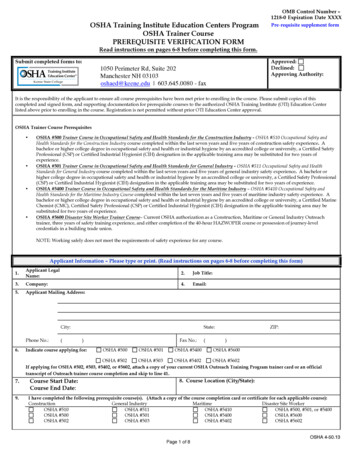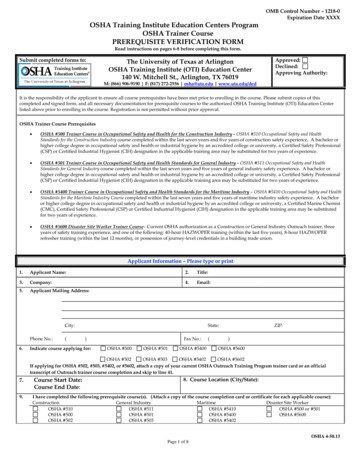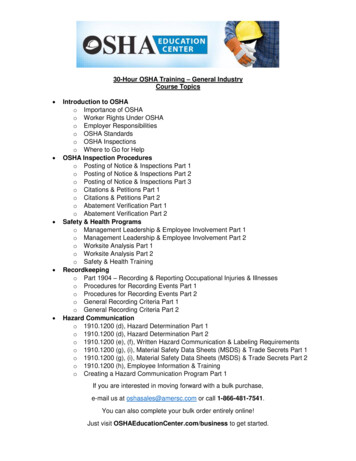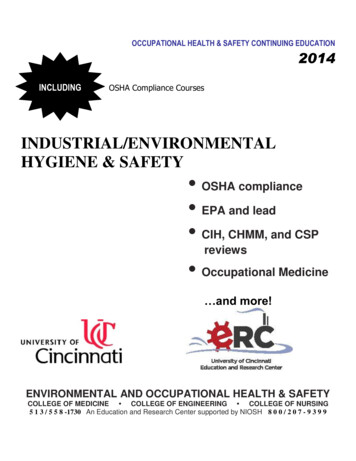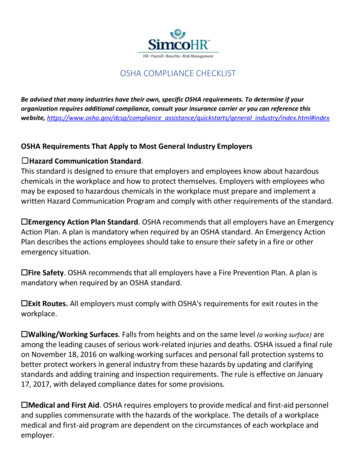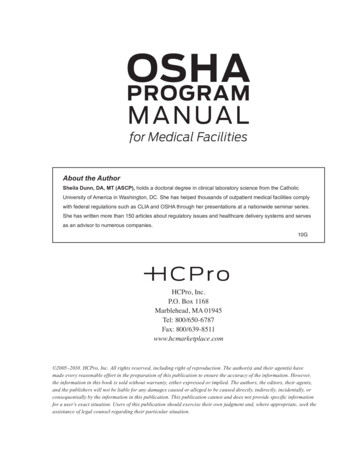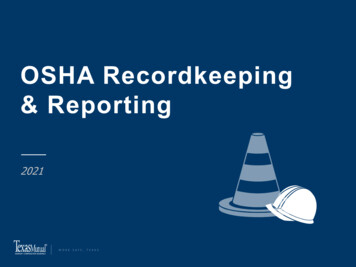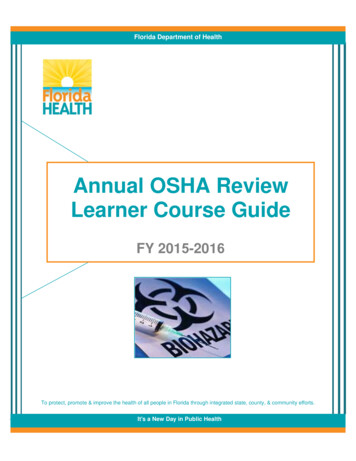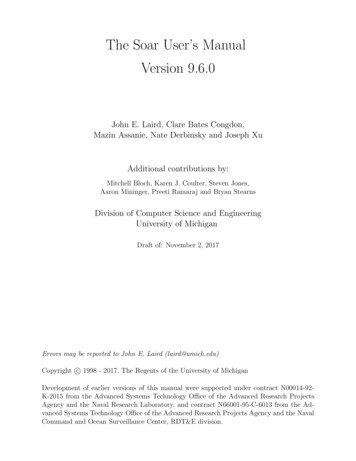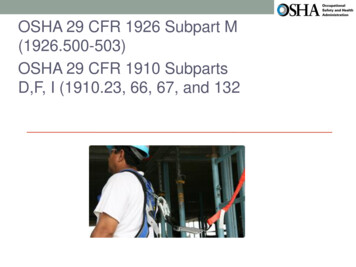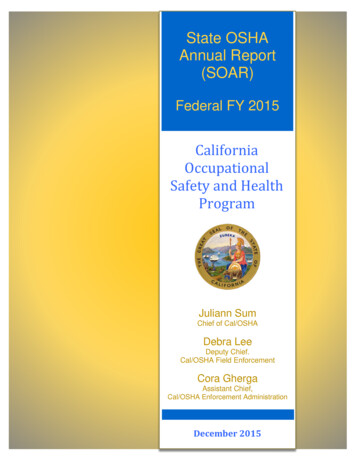
Transcription
State OSHAAnnual Report(SOAR)Federal FY 2015CaliforniaOccupationalSafety and HealthProgramJuliann SumChief of Cal/OSHADebra LeeDeputy Chief.Cal/OSHA Field EnforcementCora GhergaAssistant Chief,Cal/OSHA Enforcement AdministrationPage 1 of 33December 2015
EXECUTIVE SUMMARYThe Cal/OSHA annual report documents progress toward achieving the Cal/OSHA strategic vision ofbecoming a model agency that promotes workplace safety and health by motivating employers andemployees to be actively involved in preventing hazards, which would lead to reduced injuries andillnesses on the job.The role of Cal/OSHA is to enforce safety and health regulations for employers who are not incompliance with the law through enforcement efforts, and to provide compliance assistance throughtargeted outreach, education and training and to emphasize increased awareness on the part of bothemployers and employees of the importance of a safety and health culture.Cal/OSHA strives to provide as many employers as possible with assistance in achieving voluntarycompliance with Cal/OSHA standards before enforcement measures become necessary—and, moreimportantly, before an employee is injured or killed.Traditional enforcement methods aresupplemented by incentive and education programs and targeted outreach that encourage voluntarycompliance. Partnership and cooperative programs leverage Cal/OSHA’s resources.In accordance with the requirements of the Government Performance and Results Act (GPRA),California developed a Five-Year Strategic Plan covering the period 2013 through 2017. The Five YearStrategic Plan incorporated the three federal OSHA goals as its direction. The three overall strategicgoals are:Goal 1. Secure safe and healthy workplaces, particularly in high-risk industries, and improveworkplace safety and health through enforcement and consultative assistance.Goal 2. Promote workplace cultures that increase employer and employee awareness of,commitment to, and involvement in safety and health.Goal 3. Maximize Cal/OSHA's effectiveness and enhance public confidence.The Fiscal Year (FY) 2015 Annual Performance Plan developed by Cal/OSHA was intended to supportthe overall goals of the five-year Strategic Plan. The 2015 Performance Plan included specificperformance goals designed to produce measurable progress toward realization of Cal/OSHA’sstrategic goals. Performance goals include: Reducing fatalities and occupational injuries in construction and agriculture; Reducing injuries, illnesses and fatalities in selected high hazard industries with a goal of removing the industry from the High Hazard Industries list due to decreased injury and illnessrates;Reducing fatalities and occupational injuries and illnesses in refineries and other industrieswhich fall under the requirements of the Process Safety Management standard;Raising awareness of heat illness prevention among employees and employer groups inoutdoor places of employment;Improving communication and interaction with high-risk worker organizations regardingworkplace safety and health;Promoting voluntary compliance by offering employers a variety of partnerships includingrecognition and exemption programs; andEffective response to mandates so that workers are provided full protection under Cal/OSHA bytimely issuance of citations, so that hazards could be timely corrected, and by timely responseto work related fatality reports.This annual report for Cal/OSHA Enforcement reflects the integrated approach to achieving goals whichwere stated in the Cal/OSHA Strategic Plan. Cal/OSHA Enforcement programmed and self-referralactivities have continued to be coordinated to ensure the greatest impact on selected industries with thehighest preventable injury, illness and workers’ compensation rates.Page 2 of 33
FY 2015 ACCOMPLISHMENTSCalifornia continued to encounter many challenges over the past few years. Budgetary constraints atState level at the beginning of the decade, along with the Federal Budget sequester in 2013, whichresulted in a continued reduction of the 23(g) grant funding, created obstacles for Cal/OSHA in hiringmuch needed personnel, particularly field staff. However, starting on July 1, 2013, concerted effortsmade by the Department of Industrial Relations (DIR) and by Cal/OSHA were successful eachconsecutive year in obtaining State authorization and funding for significantly increasing staffing.Initially, Cal/OSHA was authorized to backfill all of the positions having become vacant as of that date,then State funding for additional 31 Enforcement positions was provided starting on July 1, 2014.Furthermore, starting on July 1, 2015, Cal/OSHA obtained approval and funding for 43 new positions inEnforcement and Enforcement-support units, for which the recruitment and hiring efforts are continuing.During this past fiscal year, Cal/OSHA in collaboration with the Occupational Safety and HealthStandards Board developed, proposed, amended and promulgated a significant number of regulations,some of which are the first in the nation, broadening the range of hazards from which workers are to beprotected.Cal/OSHA continued its sustained outreach efforts, which were complemented by the newly created orupdated publications. Although previous fiscal years’ budget restrictions resulted in the elimination of23g positions that had been dedicated to Research and Education (publications), and since thesepositions dedicated to publications creation have not been restored to date, DOSH implemented aresponsible and creative alternative approach to that end. Educational publications are primarilycreated in draft form by a 23g staff member in the Consultation Program. The draft document is thenreviewed and edited by Consultation senior staff, Research and Standards staff, the DOSH Legal Unitand lastly by the DIR Public Information Office.Publications that were updated or newly created and posted on the public web site are listed below: Health & Safety Rights: Facts for California Workers (new)Safety and Health Protection on the JobHazard Communication and the Globally Harmonized System (new)Protecting Temporary Agency Employees (new)Cal/OSHA Pocket Guide for the Construction Industry 1Heat Illness Prevention eToolTree Work Safety (new)Tree Work Checklist (new)Recordkeeping eToolFall Protection in Construction (new)Injury and Illness Prevention Model Program for Non-High Hazard Employers (new in Spanish)Access to Medical RecordsWorking Safely in Nail Salons (new in Spanish and Vietnamese)Significant achievements were realized in the training and professional development of Cal/OSHA staff,by more than doubling the number of compliance personnel who completed the training requirementsfor new compliance officers, and by offering the highest volume of advanced technical training for staffsince the 1990s.Another area of substantial progress has been the updating, reorganization and expansion ofinstructions and other information on Cal/OSHA’s Internet pages (for stakeholders and public), andIntranet pages (for staff).1 A comprehensive revision of the Pocket Guide for the Construction Industry should be available in print by February 2016Page 3 of 33
As result of all these sustained efforts, throughout the challenges posed by the improving economywhile maintaining fiscal responsibility, Cal/OSHA has persevered, achieving and surpassing many ofthe activity measures set forth in the FY 2015 Annual Performance Plan. More important even,California observed a significant drop in the rate of work-related injuries, illnesses and fatalities.Enforcement and Outreach/Educational ActivitiesThis Federal fiscal year, Cal/OSHA Enforcement successfully conducted a total of 7,585 inspections,exceeding the goal to conduct 7,100 inspections. The aforementioned inspections comprised 7,141private industry inspections and 444 public sector inspections. During this time, Cal/OSHA identified17,527 hazards, potentially affecting the estimated 6.5 million workers employed at theseestablishments. Of the hazards identified, 19 resulted in willful, 99 in repeat, and 18 in failure-to-abatecitations 2. These numbers, however, are expected to increase as information continues to be dataentered into the Federal Integrated Management Information System (IMIS) and the OSHA InformationSystem (OIS).Enforcement ublicInspectionsPrivateInspections200010000FY 2015 GoalInspections ConductedFFY 2015 YTD(IMIS & OIS)While enforcement activities are critical to the Cal/OSHA program, education and outreach are alsovaluable components to the success of its mission. To achieve this, Cal/OSHA teamed up withworkers’ compensation insurance providers, employer groups and associations, including smallbusinesses representatives, and others to participate in various training and outreach seminarsthroughout California to help employers become self-sufficient in reducing occupational injuries andillness and workers’ compensation losses. Topics covered during these seminars have included:establishing an effective Injury and Illness Prevention Program (IIPP); recognizing the most frequentlycited hazards; understanding Cal/OSHA and the inspection process; how to prepare for an inspection;employer/employee rights and responsibilities; heat illness prevention; new Cal/OSHA standards, andother industry specific topics.Cal/OSHA has also availed of opportunities to participate in community outreach events to give a faceto Cal/OSHA and reach out to the public it serves. This is particularly important when the targeted2Federal IMIS Inspection Report dated November 16, 2015 and OIS Inspection Summary and Inspection One-Liner Reports dated November 18, 2015.Page 4 of 33
audience is the limited or non-English speaking population that is often reluctant to report hazardousconditions in the workplace.Injuries, Illnesses and FatalitiesCal/OSHA firmly believes these combined enforcement and educational efforts have contributed to thereduction of California’s already low on-the-job total recordable case (TRC) injury and illness incidencerate of 3.8 3 in CY 2014. Please see the following graph.In addition to these low rates for the last calendar year, the overall decreasing trend from 1996 to 2014is impressive, both parameters showing reductions of over 35%.Nonfatal injury and illness incidence rates by case type, 1996-2014All industries (incl. State and Local Govt.)9Incidence rate per 100 full-time 2.34.04.04.02.22.32.23.82.22101996 1997 1998 1999 2000 2001 2002 2003 2004 2005 2006 2007 2008 2009 2010 2011 2012 2013 2014TRC Total Recordable CasesDART Days Away Restricted or TransferredThe rate of fatalities for CY 2013 was 2.4 per 100,000 full-time equivalent (FTE) workers as reported bythe Census of Fatal Occupational injuries (CFOI) 4. Although this number represents a slight increasecompared to CY 2012 which had a rate of fatalities of 2.3, the California CY 2013 fatality rate is lowerthan the national rate of fatal work injuries for civilian workers in CY 2013 of 3.3 per 100,000 full-timeequivalent (FTE) workers 5 (2.4 fatality rate for California compared to 3.3 national data). California finalfatality rates for CY 2014 are not currently available; however the preliminary data reflect a double digitdecrease in the number of fatalities from the final 2013 data.The tables below provide a quick comparison of fatality rates between the national and California databy industry type, and show that except for transportation-related incidents, all other industriesexperienced lower rates in California than nation-wide.3Table 1. Incidence rates of nonfatal occupational injuries and illnesses by selected industries and case types, 2014 le1.pdf4 2013 Census of Fatal Occupational Injuries Fatal Work Injury Rates, California available at http://www.bls.gov/iif/oshwc/cfoi/rate2013ca.pdf5 Fatal occupational injuries, total hours worked, and rates of fatal occupational injuries by selected worker characteristics, occupations, and industries, 2013 available athttp://www.bls.gov/iif/oshwc/cfoi/cfoi rates 2013hb.pdfPage 5 of 33
California Fatality hing &huntingConst9.26.5Mfg2.0Transportation& Utilities9.1Whsle.and retailtrade2.4Prof. andbusinessservices2.2Educ. andhealthservicesLeisure ublicAdmin0.61.51.5Prof. andbusinessservicesEduc. andhealthservicesLeisure andhospitalityOtherservices,except publicadmin.Gov’t.2.80.71.92.72.0National Fatality RatesFatalityRate2013TotalAg, forestry,fishing ation & and retailUtilitiestrade5.12.6Page 6 of 33
SPECIAL INITIATIVESHeat Illness PreventionHeat illness prevention once again continued to be a major emphasis of the Cal/OSHAprogram. Educational and enforcement efforts were continued in 2015 due to the Division’scommitment to heat illness prevention through enforcement and outreach; significant changes to theHeat Illness Prevention Standard; as well as due to enhanced focus on heat illness prevention byfederal OSHA.The OSHA national emphasis program on heat illness prevention was inspired by work done inCalifornia. Many of the materials used in the federal OSHA efforts were adapted from Heat Hazards inAgriculture – a Guide for Employers to Carry Out Tailgate Training for Workers, developed byCal/OSHA and the University of California, Berkley, Labor Occupational Health Program.Using these and other materials, Cal/OSHA continued to provide extensive training and outreach on thenewly revised heat illness prevention standard and stressed the importance of preventive measuresthroughout the year, but especially during the warmer months. Critical to this endeavor was thepartnering with industry, community, and labor groups to educate employers and workers on the stepsneeded to prevent occupational, heat-related illnesses and fatalities.Cal/OSHA conducted multiple public stakeholder meetings on the issue of heat illness prevention. Theconcepts and ideas shared and generated by the stakeholders at these meetings resulted in draftchanges to the Heat Illness Prevention Standard that were then submitted by Cal/OSHA to theStandards Board for review, public hearing, and finally adoption.The changes to the Heat Illness Prevention standard highlighted the importance of prevention andimmediate and appropriate response to signs and symptoms of heat illness. The trigger temperaturefor shade was dropped from 85 degrees to 80 degrees. The degree of availability of shade waschanged from 25% of the crew to 100% of the crew on required breaks and for those seeking apreventative cool down rest. Heat illness awareness, first aid, and emergency response sections wereenhanced to address the need for acclimatization procedures, supervisor awareness of signs andsymptoms, and prompt attention, first aid, and emergency care for those affected by heat illness. Othersections of the standard were also revised. Cal/OSHA created a guidance document, available s-Prevention-Regulation-Amendments.pdf, to furtherassist employers and employees in understanding the revisions to the standard.Cal/OSHA continued an extensive campaignto ensure that all outdoor workers areprotected from heat illness. The ongoingcampaign combined outreach and educationwith strong enforcement to ensure that allemployers with outdoor workers know andcomply with the Heat standard. The targetindustries were agriculture, construction, andlandscaping, with additional focus on otherindustries such as oil and gas, and utilities.Cal/OSHA continued extensive utilization of aspecial Bilingual Outreach Team (BOT)consisting of Spanish speaking retiredannuitants.Page 7 of 33
Cal/OSHA has partnered with agricultural and construction industry groups, insurance carriers andothers again this year in order to provide training and outreach to employers, supervisors and workcrews on heat illness prevention. By the end of the FY, Cal/OSHA staff participated in approximately200 events in which heat illness was discussed.As in past years, bilingual training efforts were augmented with television interviews, and regularparticipation in radio programs to raise awareness of the Cal/OSHA program, how to file a complaint,heat illness prevention and field sanitation issues. Paid radio and billboard advertisements targetingoutdoor workers throughout the State continued again during 2015.Compliance with the Heat standard, both the previous version and the revised one that was effectiveMay 1, 2015, was addressed during inspections of industries with outdoor employment year round.Nonetheless, enforcement actions intensified during the summer in areas with forecasted heat waves.The summer’s enforcement resulted in the issuance of one heat-related Orders Prohibiting Use(OPUs). As of November 2015, Cal/OSHA found better compliance related to heat illness prevention inagriculture, approximately 80% versus construction, at approximately 75%.The following graph represents the year round enforcement and outreach activities from calendar year(CY) 2005 through CY 2014.Heat Illness Enforcement and Outreach ActivitiesCY 05 - 7908CY10CY1161450001145112110182055392 14CY05234 136CY0696284CY07CY08Inspections (coded S18HEAT)CY09Violations of 3395 citedCY12CY13CY14heat outreach (enf and cons)Note: The S18HEAT coding of inspections indicates that heat hazards were evaluated in those inspections in addition to other safety and health hazardsThe ongoing efforts to enforce and educate the workforce about the dangers of heat illness continue toproduce positive results. Cal/OSHA continues to see higher compliance rates with the heat illnessregulation, from 32% in CY 2006 (the first full year after adopting the regulation) to almost 66% overallin CY 2014.In CY 2014, there was one confirmed heat related fatality compared to 10 in CY 2005, when the initialemergency standard was passed. California has seen a 90% decrease in heat related fatalities in theworkplace since CY 2005, while the nation as a whole, as reported in BLS statistics, has experienced aPage 8 of 33
38% decrease in reported heat fatalities during this same time, from 34 to 18. 6 Please see the graphbelow.Fatal Exposure to Outdoor Heat65605550454035302520151050CY 05 - 142005200620072008200920102011201220132014All USA47443227414061313418CA-Fatal10816122341"USA" Source: United States Department of Labor - http://www.bls.gov/iif/home.htm#data (2014 preliminary data as of 11/19/15)To date for 2015, California has zero medically confirmed fatality cases related to outdoor l heatexposure. Ten suspect heat fatalities are pending medical records review as of this writing. Finalenforcement outcomes are still pending at this time. The following table indicates the distribution offatalities due to outdoor heat exposure, by industry, for the 2005-2015 YTD period.California Worker Fatalities Due to Outdoor Heat Exposureby 0116112220122013102014 2015 YTDThe national statistics may not be entirely comparable in that they may include cases of indoor heat-related fatalities, while California’s are focused on outdoor heat cases."USA" Source: United States Department of Labor - Bureau of Labor StatisticsPage 9 of 33
Safety Awareness Campaign for RoofersIn March 2015, Cal/OSHA launched a safety awareness campaign for roofers, where the workplaceincidence of serious injuries and fatalities is higher compared to other industries.Between 2012 and 2014, Cal/OSHA conducted 126 investigations of roofing operations where anaccident occurred. A full three out of four of those accidents occurred at roofing operations that werefound to be in violation of state safety regulations.Falls are the leading cause of death andserious injury for roofing workers. Forexample, in December 2013, a WestCoast Roofing employee fell 36 feet tohis death at a job site in Ventura.Investigators found that the victim hadnot been wearing fall protectionequipment or a positioning system.West Coast Roofing was cited 22,360for 10 violations, including two serious innature. Another tragic and preventablecase occurred earlier that year in June2013, when a Midwest Roofing & Solaremployee fell approximately 17 feetfrom the unprotected edge of anapartment building roof in Pico Rivera,and died five days after the accident.Cal/OSHA cited Midwest Roofing &Solar 39,600 for five serious violations.Cal/OSHA’s “Roofing Maximum Enforcement Program,” took place from March through November, andcalled for targeted inspections of roofing operations across the state, with the goal to raise awareness foron-the-job safety in the roofing industry so that hazards are identified and corrected. Approximately 200inspections were conducted pursuant to this initiative, and their results are still being tallied andevaluated.Fall protection was one of the main items evaluated during the inspections, from railings on buildings topersonal devices such as a hook that connects a worker’s vest to a lanyard that attaches to ananchorage point. Inspections also included evaluation of safe access to rooftops and protection fromelectrocution hazards posed by overhead power lines. Additionally, employers’ heat illness preventionprogram was reviewed in each inspection, given that in roofing operations reflected surfaces canincrease the heat factor of the climate.Cal/OSHA offers online resources for workers and employers, with a fact sheet on preventing slips andfalls for roofers and other safety publications.Communicating with the Limited and Non-English Speaking WorkforceDirect communication with limited and non-English-speaking workers and their employers continues tobe a high priority for Cal/OSHA. Starting in 2002, Cal/OSHA sought to overcome language barriersbetween Cal/OSHA staff and the limited and non-English speaking workforce by increasing the numberof in-house certified bilingual employees, which at the time were 26. By September 2015, Cal/OSHA’sbilingual staff (in various languages) had risen to 56 employees who passed the state’s languagePage 10 of 33
certification exam. These efforts were supplemented by contracting with an external translationservice, providing a network of native-speaking language interpreters telephonically available for over100 languages and dialects for those instances where an in-house bilingual employee was not readilyavailable or staff was unable to identify the language spoken.Cal/OSHA’s commitment to serve the growing number of limited and non-English-speaking workers inCalifornia was reaffirmed in 2011 by the introduction of the Language Learning Project. The Cal/OSHALanguage Learning Project provides tuition fees, books, and paid study time for employees interestedin learning a second language after work hours at a community college, UC/CSU extension, or otherlocal provider (on-line courses excluded). Cal/OSHA continued to make this program available toemployees in FY 2015. Although Spanish is the current priority, Cal/OSHA is also considering otherlanguages in the future as well.Professional Training and CertificationIn 2011, Cal/OSHA revitalized its Professional Development and Training Unit (PD&TU) to enhanceand maintain the professional expertise of its Enforcement and Consultation staff. An internalCal/OSHA Training Committee was formed and the PD&TU is implementing the federal trainingrequirements for both longtime staff and recent new hires. Training includes both in-service classesand webinars conducted by DOSH staff and out-service classes taught by academic institutions andprofessional organizations in the State.In 2015, the number of compliance personnel who completed the training requirements for newcompliance officers more than doubled, and the volume of advanced technical training for staff was thehighest since the 1990s.As a way of encouraging professionalism of its field staff, Cal/OSHA began in 2011 to support staff inachieving certification in their fields. In FY 2015, the Division continued to offer to fund tuition, booksand to provide paid study time for staff interested in taking a Certified Safety Professional (CSP) exampreparation course at UC Davis or UC San Diego. Requirements for enrollment in the preparationcourse include a four-year college degree, three years of experience, and approval by the Board ofCertified Safety Professionals (BSCP).A similar opportunity is offered to industrial hygienists interested in certification as well. Because thereare numerous Certified Industrial Hygienist (CIH) exam preparation courses offered throughoutCalifornia, Cal/OSHA industrial hygienists interested in certification can apply for the course and, ifapproved, the Division will fund their participation as well.Page 11 of 33
PARTNERSHIPS / COMPLIANCE ASSISTANCEEmployment Education and Outreach (EMPLEO)The Employment Education and Outreach (EMPLEO) was established as an alliance to provideSpanish-speaking employees and employers with information on federal and state workplace laws. Thispartnership is two-fold: helping workers know what rights and protections they have, and helpingemployers know what resources there are available to them. Partners in the EMPLEO program includethe U.S. Department of Labor’s Wage and Hour Division; OSHA; the U.S. Equal OpportunityCommission; California Division of Labor Standards Enforcement; Cal/OSHA; the consulates of Mexico,El Salvador, Guatemala, Honduras, Nicaragua and Costa Rica; the regional Hispanic Chamber ofCommerce; and the Coalition of Human Immigration Rights in Los Angeles, among others.Cal/OSHA is proud to be part of this program since its inception in 2004, providing information andassistance to Spanish-speaking workers and employers regarding their rights and responsibilities, andresponding to workplace complaints.Alliance with the Mexican ConsulatesThe California Department of Industrial Relations(DIR) joined the U S Department of Labor inlaunching the annual Labor Rights Week at SanFrancisco’s Mexican Consulate. The openingceremony included the signing of an alliance withDIR’s Cal/OSHA, Federal OSHA and the MexicanConsulates in California to assist in educatingMexican workers on their labor rights, as part of theOSHA Alliance Program.2015 was the seventh year when DIR and itsrepresentatives from Cal/OSHA, the LaborCommissioner’s Office and Division of Workers’Compensation participated in Labor Rights Weekseminars at all 10 Mexican Consulates across thestate.OSHA’s National Falls Campaign Stand DownThe Cal/OSHA Enforcement and Consultation Services Branches actively participated in OSHA’sNational Falls Campaign Stand Down, which was held in May, 2015. Staff participated in even morestand down functions than in the previous year, and activities included fall protection personal protectiveequipment (PPE) demonstrations, tool box training and formal presentations by Cal/OSHA andconstruction company senior management. Cal/OSHA also worked diligently to announce the campaignon its website and through speeches and the Cal/OSHA Reporter, and was very successful in “gettingthe word out” to many construction companies throughout the state.Page 12 of 33
Participation in the Labor Enforcement Task Force, Roofing Compliance Working GroupDuring the 2015 FY, Cal/OSHA continued its full participation in the Labor Enforcement Task Force(LETF), which combats the underground economy in California to create an environment wherelegitimate businesses can thrive. In this joint effort between state agencies and affected communities,information and resources are shared to ensure hard-working, compliant business owners and theiremployees have an opportunity for healthy competition.The Roofing Compliance Working Group (RCWG) started as an arm of LETF, was launched inSeptember 2013 and has continued its activities throughout FY 2014, to enforce safety and labor lawstandards in this key industry in California. RCWG is a collaboration of State and local agencies, aswell as labor and management, and its objectives include a rapid, real time response to complaints ofworkplace health and safety hazards in the roofing industry, as well as investigation of complaintsrelated to payroll, misclassification and workers’ compensation issues. As a pilot, RCWG has beenoperating in Alameda, Contra Costa and San Francisco counties.Roofing related falls result in deaths and devastating injuries to workers, and in very high costs ofworkers’ compensation. According to data released by Workers’ Compensation Insurance RatingBureau, there were 367 roofing-related falls from scaffolds, ladders, elevations, and into openings suchas skylights in California from 2008 to 2010, resulting in total indemnity and medical costs of over 70million.The Roofing Compliance Working Group comprises Cal/OSHA and the Division of Labor StandardsEnforcement (both divisions of the Department of Industrial Relations), as well as the EmploymentDevelopment Department, the Contractors’ State Licensing Board, the State Compensation InsuranceFund, two local District Attorney Offices, U C Berkley’s Labor Occupational Health Program, AssociatedRoofing Contractors, the Bay Area Roofers Labor – Management Trust, and two Roofers andWaterproofers Union Locals.This partnership program resulted in 18 inspections by Cal/OSHA, and various other enforcementactions by its partners. Cal/OSHA found violations in most of these inspections, with serious violationsidentified in many of the cases.Page 13 of 33
Participation in High Rise RescueIn Octobe
IMIS) and the OSHA Information System (OIS). While enforcement activities are critical to the Cal/OSHA program, education and outreach are also valuable components to the success of its mission. To achieve this, Cal/OSHA teamed up with workers' compensation insurance providers, employer groups and associations, including small
